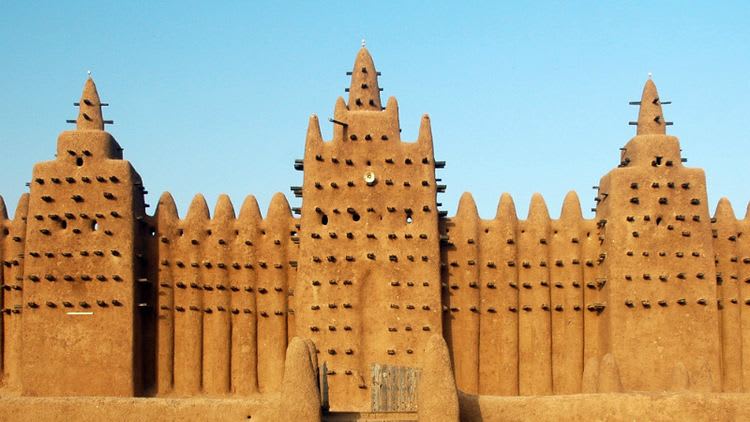Top 5 Most Influential African Empires in History
Africa boasts of a rich culture and history that cuts across socio-political and economic dominance. The continent’s diverse historical ethnicity is proof that Africa was once home to some of the world’s renowned empires to date. Exponential tourist visits in African countries are a testimony of how these empires have stood the test of time. Here is a list of the top five most influential kingdoms in African history:
1. The Mali Empire
The Mali Empire dominated West Africa between the 9th and 16th centuries. This paramount kingdom was a marvel during its epoch. Rising to prominence in the region during the twilight years of the Ghana Empire, at its peak, the Kingdom of Mali would stretch across a territory so large that its only contemporary superior in terms of landmass conquered, was the Mongolian Empire of East Asia. The Empire’s most important cities were Djenné and Timbuktu, both of which were renowned for their elaborate adobe mosques and Islamic schools.
What distinguishes this African empire from the others is its renowned wealth in the form of gold. One of the most prominent Emperors to reign in this kingdom was Mansa Musa, whose pilgrimage to Mecca remains a historical wonder. It is recorded that he led an empire endowed with inexhaustible gold reserves which he used to develop the kingdom. Mansa Musa developed cities like Timbuktu and Gao into important cultural centres.
He also brought architects from the Middle East and across Africa to design new buildings for his cities. Mansa Musa turned the kingdom of Mali into a sophisticated centre of learning in the Islamic world. At the height of its dominance, the ancient kingdom of Mali spread across parts of modern-day Mali, Senegal, the Gambia, Guinea, Niger, Nigeria, Chad, Mauritania, and Burkina Faso.
2. The Kingdom of Kush
This ancient Nubian empire ruled over a vast territory along the Nile River, in what is modern day Sudan starting from around 785 BC. The Kingdom of Kush was so powerful that it even ruled its famous neighbour to the north, Egypt, as the 25th Dynasty, which meant the monarchs of Kush were also the pharaohs of Egypt. The Kingdom thrived for over a thousand years and was a centre of trade for iron and gold. Kushites also mummified their dead and built their own types of pyramids. In fact, the ancient Kushite capital of Meroe is home to ruins of over 200 pyramids, far more than Egypt.
With a rich cosmopolitan outlook, the Nubian cultures were sophisticated as the region served as a major trading centre for goods from the African interior, Arabian Desert, and Mediterranean basin. The legendary Kingdom of Kush, helped define the cultural and political landscape of north-eastern Africa. Centred on three Kushite kingdoms ; Kerma, Napata, and Meroe, the Kingdom of Kush exerted its influence for about 3000 years, establishing itself a place as one of the most revered kingdoms biblically. Moses’ wifeZipporah, is believed to have been of Kushite ancestryand was described in the Numbers as a Kushite woman.
3. The Great Zimbabwe Empire
Famously regarded as the origins of modern day Zimbabwe, the Great Zimbabwe Kingdom comprised magnificent architecture. Featuring on UNESCO’s world heritage sites, the ancient kingdom was known for its vast natural resources comprising gold, copper and iron. Arguably southern Africa's earliest and largest Iron Age city-state, the empire developed as a trade centre with participants from as far as Asia , Arabia and Portugal. The kingdom was once fancied by historians as the residence of the Biblical Queen of Sheba- Ophir. Vasco da Gama's companion Tomé Lopes reasoned that Ophir would have been the ancient name for Great Zimbabwe in Zimbabwe, the main centre of southern African trade in gold in the Renaissance period.
What places the Great Zimbabwe Kingdom among the top most influential African kingdoms is an imposing collection of stacked boulders, stone towers and defensive walls assembled from cut granite blocks. These formed the royal residence, storage of goods and fortress during war. Neither the first nor the last of some 300 similar complexes located on the Zimbabwean plateau, Great Zimbabwe is set apart by the terrific scale of its structure. Its most formidable edifice, commonly referred to as the Great Enclosure, has walls as high as 36 feet extending approximately 820 feet, making it the largest ancient structure south of the Sahara Desert
The level of civilisation that was put into developing this magnificent structure has led some Eurocentric historians to suggest that it was the Greeks who built it. However, modern historical research through archaeology and oral tradition concluded that the majestic Great Zimbabwe was built by the Shona locals who resided in the area. This was because of the chevron patterns that form a design for all the stone walls around the area, a culture that was associated with the Shona people in their art including pottery and rock painting. At its decline, the empire gave birth to such prominent kingdoms as the Munhumutapa, Rozvi and Torwa kingdoms.
4. The Kingdom of Aksum
The Aksumite kingdom covered an enormously huge land area consisting of modern day Ethiopia, Eritrea, Djibouti, Egypt, Saudi Arabia, Somalia, South Sudan, Sudan, and Yemen. This ancient empire is one of the oldest of the African kingdoms .This kingdom spread across what is today Ethiopia and Eritrea in an area where evidence of farming dates back 10,000 years.
The Aksumites were key players in the commercial trading routes which existed between the Romans and Ancient India. They were considered one of the four great powers of their time alongside China, Rome, and Persia. The Aksumites erected several stelae (stone wooden slabs acting as monuments in pre-Christian times) during their reign but one of them is the most famous of all. Standing at 79 feet, the Obelisk of Axum is approximately 1700 years old and is found in present-day Axum, Ethiopia.
Later, when the Aksumites converted to Christianity, they unwittingly created the foundations for Ethiopia’s Orthodox Church. Today S.t Mary of Zion Cathedral in Axum is rumoured to be the resting place of the biblical Ark of the Covenant.
5. Carthage Empire
Carthage, a city state, was founded in the 8th century in what is modern day Tunisia. This powerful empire had a massive economy based on textile, gold, and silver trading. It is also revered for its competitive military establishments that enabled the state to wade off Rome’s threats in the Punic wars. This conquest empire is infamous for its participation in a number of wars with the Greeks in the Sicilian wars and the Romans in the Punic wars.
As a commercial hub, the city had close to half a million residents and docking bays for 220 ships. Due to the desire of Carthage to expand to Spain and other parts of the Mediterranean, conflict with the Roman Republic began. The ancient superpowers clashed in the three bloody Punic Wars, the last of which ended in 146 B.C. with the near-total destruction of Carthage.

Munashe O'brian Gutu
A pan-African son of the soil with a vision to impart and unravel the rich African history. Penning Afro-centric perspectives to de-mystify long-standing propagandist biases. Africa rise!
follow me :
Leave a Comment
Sign in or become a Africa Rebirth. Unearthing Africa’s Past. Empowering Its Future member to join the conversation.
Just enter your email below to get a log in link.


Related News
The Rise and Fall of the Ancient Oyo Empire
Nov 26, 2023
How Ancient Egyptian Knowledge Influenced the Invention of Electricity
Aug 29, 2022
The Inhumane Treatment of African Slaves Before Departure to the Land of No Return
Apr 30, 2022